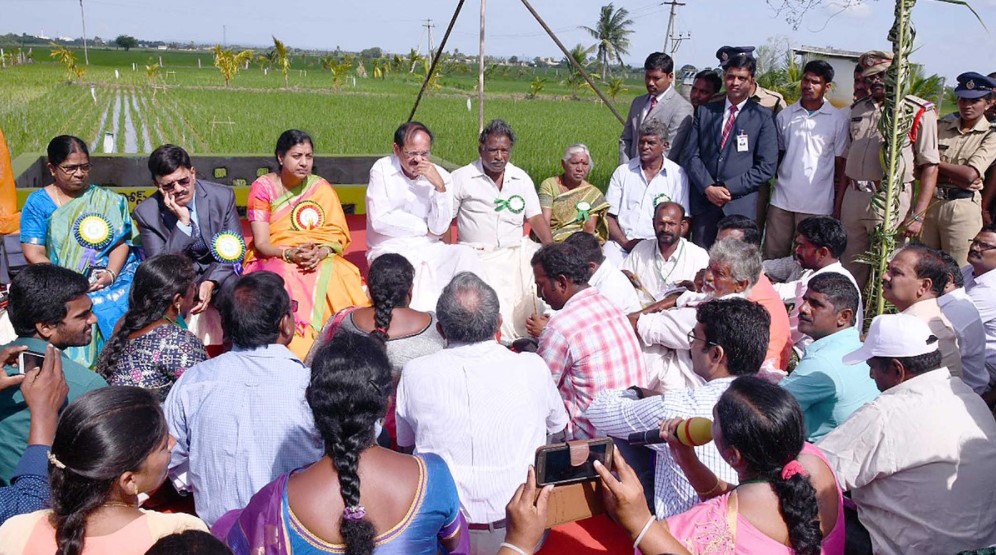
The recent farmer protests following the 2020 Indian agriculture acts have brought to the fore several debates regarding India’s agricultural framework. One of these debates has been around the ecological and economic sustainability of the current agricultural practices, many of which are rooted in the Green Revolution policies implemented in the 1960s. While the Green Revolution is believed to have been pivotal to India’s attainment of food security, its social and environmental fallouts have been immense. Degraded soil quality, critically low water tables, farmer indebtedness and suicides and increased vulnerability to climate change – all of these consequences have ensued from the chemical and irrigation-intensive farming methods introduced by Green Revolution policies. According to National Sample Survey Office (NSSO) data, almost 70% of agricultural households in India spend more than they earn, and more than half of all farmers are in debt. In the 2019-20 Union Budget, Finance Minister Nirmala Sitaraman introduced “Zero Budget Natural Farming” and emphasised that it could allow for a doubling of farmers’ incomes.
What is ZBNF?
ZBNF, or “Zero Budget Natural Farming”, is a method of chemical-free agriculture that draws upon traditional Indian practices. It was originally promoted by Maharashtrian agriculturist and Padma Shri recipient, Subhash Palekar. He developed it in the mid-1990s as an alternative to the Green Revolution’s methods driven by synthetic fertilizers and pesticides and intensive irrigation (Jebaraj). Palekar argued that the rising costs of numerous external inputs was the primary cause of farmer indebtedness and suicides, and that these chemicals had a detrimental long-term impact on the environment and soil fertility. “Zero Budget” refers to the idea that farming can be carried out without needing to purchase these expensive inputs, and hence break the debt-cycle for many small farmers.
The Social and Environmental Impacts of the Green Revolution
Conventional industrial farming typically involves the application of synthetic fertilisers and pesticides, the use of high-yielding seed varieties and extensive irrigation. Crops are grown in monocultures, meaning only one kind of crop is grown on a given plot of land. In India, the Green Revolution methods were first introduced in Punjab,Haryana and Western Uttar Pradesh in the late 1960s, and have since spread to other parts of the country. Over the decades, these practices have resulted in numerous environmental issues. Firstly, the new varieties of seeds required high amounts of water, fertiliser and pesticides. Over time, the use of pesticides and fertilisers has continued to increase. The overuse of these chemicals has resulted in the physical and chemical degradation of soil due to the altering of natural microflora and increased soil alkalinity and salinity. This has caused a vicious cycle of depleted soil fertility, which then requires the application of increasing quantities of fertilisers and pesticides to sustain yields, leading to further soil degradation. Moreover, the excessive use of groundwater for irrigation has depleted the water table to critically low levels in many parts of the country. The monoculture of high-yielding seed varieties also resulted in a loss of many indigenous species from cultivation.
These methods resulted in a shift to increasingly unsustainable practices being adopted by farmers, both from an economic and environmental point of view. Increasing input requirements have resulted in increasing costs for farmers, while lowered yields mean much of these costs cannot be recovered. Farmers are trapped in ever-increasing debt, which has been followed by a spate of farmer suicides in several states. Many of these farmers are unable to withstand the rising costs of farming and sell their lands to large commercial farmers. Others have left farming to resort to other occupations.
Methods Entailed by ZBNF
As opposed to conventional industrial agriculture, ZBNF methods attempt to align with principles of agroecology. Agroecology shifts the focus from narrower concerns with farming to the broader interactions between soil, soil organisms, insects and environmental conditions. It also views humans as a population within the ecology, and encourages one to consider social issues such as the unequal consumption of food, food consumption practices etc. (Gliessman). ZBNF methods appear to converge with these agroecological principles on many counts. The four pillars of ZBNF are jeevamrutha, beejamrutha, acchadana and whapasa.
Jeevamrutha is a fermented microbial culture that provides nutrients and promotes the activity of microorganisms and earthworms in soil. It is made using water, cow dung, aged cow urine, jaggery, pulse flour and a handful of soil. Jeevamrutha is applied to the crops twice a month in the irrigation water – 200 litres are sufficient for one acre of land.
Beejamrutha is a treatment used for seeds, seedlings or other planting material. It is added to the seeds of any crop, and protects youngn roots from fungus or other soil and seed-borne diseases that affect plants after the monsoon. Again, it uses cow dung, cow urine, lime and soil.
Acchadana is mulching. Palekar speaks of three types of mulching: soil mulch protects topsoil during cultivation and promotes aeration and water retention, straw mulch uses dried biomass waste of previous crops and live mulch is the practice of multi-cropping where different cropping patterns are used on the same field to supply all essential elements to the soil and crops.
Whapasa refers to moisture. Palekar challenges the notion that plant roots need a lot of water, thus countering the over-reliance on irrigation present in green revolution methods.

source : commons.wikimedia
How has ZBNF Performed So Far?
ZBNF seems to be quite promising as an environmentally sustainable form of agriculture that can eliminate the need to buy expensive inputs and thus alleviate farmer indebtedness. What has been its track record so far?
In Karnataka, where the movement has been most widely adopted, the farmer association – Karnataka Rajya Raitha Sangha (KRRS) – collaborated with Palekar to adopt ZBNF practices and held a series of workshops and training camps for farmers to switch to this method of agriculture. According to a 2012 survey of farmers who converted to ZBNF in the state, 78.7% of respondents experienced an increase in yield, 93.6% experienced improved soil conservation, 85.7% experienced increased income, 90.9% reported decreased production costs, whereas 92.5% saw a reduction in the need for credit. 100% reported improvement in their own health (Khadse et al.). Even for farmers who may not have experienced greater yield, the fall in production costs resulted in increased net income.
The Andhra Pradesh Government has also taken up ZBNF to improve farmer livelihoods and fight the effects of climate change, particularly in drought-prone regions. An exploratory study in the state, conducted by a Bengaluru-based Centre for Study of Science, compared ZBNF to non-ZBNF techniques on certain crops based on six parameters: water, electricity, energy consumption, yield, net revenue and greenhouse gas emissions. It found maximum benefits in paddy cultivation, which recorded a saving of 1400-2500 cubic metres of water per acre per paddy cropping period. Electricity consumption of farms relying on groundwater reduced by 1500-3900 units per acre, and saved Rs 6000 to 16000.
This suggests that ZBNF has not only been instrumental in improving farmer incomes and livelihoods, but it has also alleviated environmental issues linked with modern-day agriculture. In India, about 70% of farms rely on groundwater, which depletes reserves. ZBNF can avoid the current drawing of groundwater by 50-60%. It could also allow for soil fertility to be recovered.
However, a caveat worth mentioning is that these studies are conducted in limited areas and a deeper investigation is needed to understand the benefit of ZBNF practices in other types of agro-climatic zones. Additionally, in states like Karnataka, the organisational strength of the KRRS was also instrumental in allowing ZBNF to take root. Several members of the KRRS comprise of elite and dominant castes that own land, so it remains to be ascertained how far the movement will help smaller, marginalised farmers and farm labour. Some criticisms of ZBNF have also centred around its rhetoric that often appears to revolve around ‘Hindu chauvinism’, wherein there is an emphasis upon the “grace of the native cow” and anything Western is demonised, even if it might be consonant with ZBNF ideals. This kind of narrative does not always appear to align with scientific principles as much as it is with political ones.
Despite this, given the severity of the agrarian and environmental crisis in India in the aftermath of the Green Revolution, ZBNF holds much promise. With increasing awareness and government funding, it can be scaled up to realise significant tangible benefits. How it is institutionalised within the policy framework and made accessible even to marginalised sections will determine the extent of its socio-economic benefits.
Ananya Vyas is a third year at Ashoka University, majoring in Political Science and minoring in Environmental Studies.


